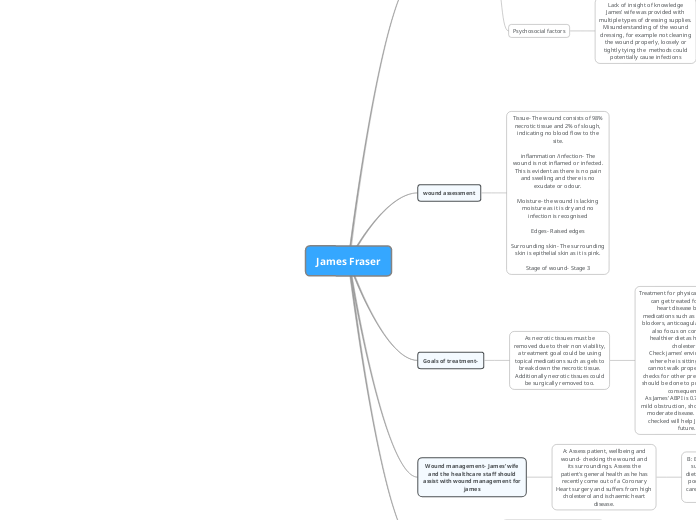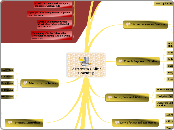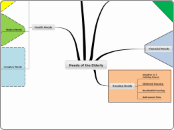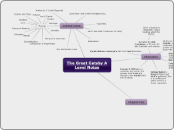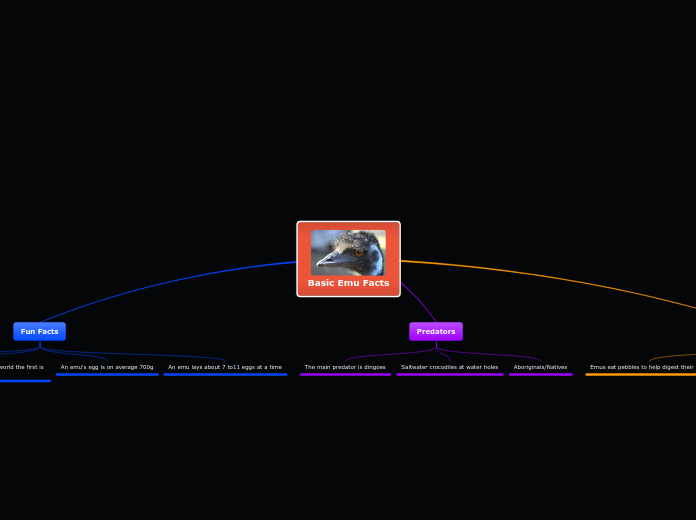James Fraser
wound productrs
Hydrogels (Intrasite gel, Duoderm
gel, Hydrosorb gel, Solugel,
Curafil) - they consist of 70-90%
water and are involved in autolytic
debriding. This will allow the
rehydration of the necrotic tissue as
it will provide a moist environment.
Hydrocolloids (Duoderm, Comfeel,
Activheal, Tegasorb, Hydrocoll and
more)
It allows the wound to clean and
debride by autolysis during
granulation and epithelialization
Wound management- James’ wife
and the healthcare staff should
assist with wound management for
james
A: Assess patient, wellbeing and
wound- checking the wound and
its surroundings. Assess the
patient's general health as he has
recently come out of a Coronary
Heart surgery and suffers from high
cholesterol and ischaemic heart
disease.
B: Bring in multidisciplinary team:
such as occupational therapist,
dietician, vascular team, pain team,
podiatrists and potentially family
carers to help his wife with wound
dressings.
control or treat underlying causes
and barriers to wound healing such
as helping him consume a healthier
diet considering his ischaemic
heart condition. If this is not
controlled, wound healing can be
prolonged
decide on appropriate treatment:
discussing treatment options with
James and his wife such as
surgically removing or biologically
removing the necrotic tissue.
Goals of treatment-
As necrotic tissues must be
removed due to their non viability,
a treatment goal could be using
topical medications such as gels to
break down the necrotic tissue.
Additionally necrotic tissues could
be surgically removed too.
Treatment for physical factors-James
can get treated for ischemic
heart disease by taking
medications such as nitrates, beta
blockers, anticoagulants. He could
also focus on consuming a
healthier diet as he has high
cholesterol.
Check james’ environment of
where he is sitting. As James
cannot walk properly, regular
checks for other pressure injuries
should be done to prevent further
consequences.
As James’ ABPI is 0.7, it indicates
mild obstruction, showing signs of
moderate disease. Getting this
checked will help James in the
future.
Treatment for psychosocial factors-
James may be given crutches to
walk on or a wheelchair so he
could get to see his friends, spend
time with them during their poker
nights and golf games.
James could go to an occupational
therapist which would provide help
managing stress, providing
company, help meet daily goals
and help maintain skill
wound assessment
Tissue- The wound consists of 98%
necrotic tissue and 2% of slough,
indicating no blood flow to the
site.
inflammation /infection- The
wound is not inflamed or infected.
This is evident as there is no pain
and swelling and there is no
exudate or odour.
Moisture- the wound is lacking
moisture as it is dry and no
infection is recognised
Edges- Raised edges
Surrounding skin- The surrounding
skin is epithelial skin as it is pink.
Stage of wound- Stage 3
Patient assessment
Psychosocial factors
Lack of insight of knowledge
James’ wife was provided with
multiple types of dressing supplies.
Misunderstanding of the wound
dressing, for example not cleaning
the wound properly, loosely or
tightly tying the methods could
potentially cause infections
Isolation and reduced activities-prior
to his surgery, James would
gather with friends for poker nights
and play golf with them 3 times a
week. Due to his surgery and
pressure injury, he would have to
stay home to look after himself.
Hence he would feel isolated
without socialising with his friends.
This could negatively impact
James’ mental health and
wellbeing, leading him feeling
psychologically stressed. Stress
decreases wound healing as the
body cannot control the
inflammatory response which is
needed in wound healing
Interference with daily life-
As James had the pressure injury,
mobilisation must have been
difficult causing him to stay home
and not play golf with his friends.
Due to immobility, the blood flow
around the body may have
decreased. This would have
interfered with wound healing as
the wound may not have gotten
enough blood supply to heal.
Physical Assessment.
Age 68. As age increases the
thickness of the skin decreases,
becoming delicate and thinner.
Resistance again shears and
resistance forces decrease. As age
increases, the dermis decreases.
Hence a delay in wound healing is
caused.
Suffers from ischaemic heart
disease and high cholesterol.
Ischaemic heart disease is when
the heart is unable to receive
sufficient blood and oxygen supply.
Since there is a lack of blood
supply in the body, the wound will
also receive a lower amount of
nutrients, prolonging wound
healing
As James had a Coronary Artery
Bypass Surgery, his mobility may
have increased. This results in a
reduced blood flow throughout the
body, especially to the lower limb.
As the pressure sore is located on
the foot, the blood supply will be
reduced, increasing the time
required to heal.
